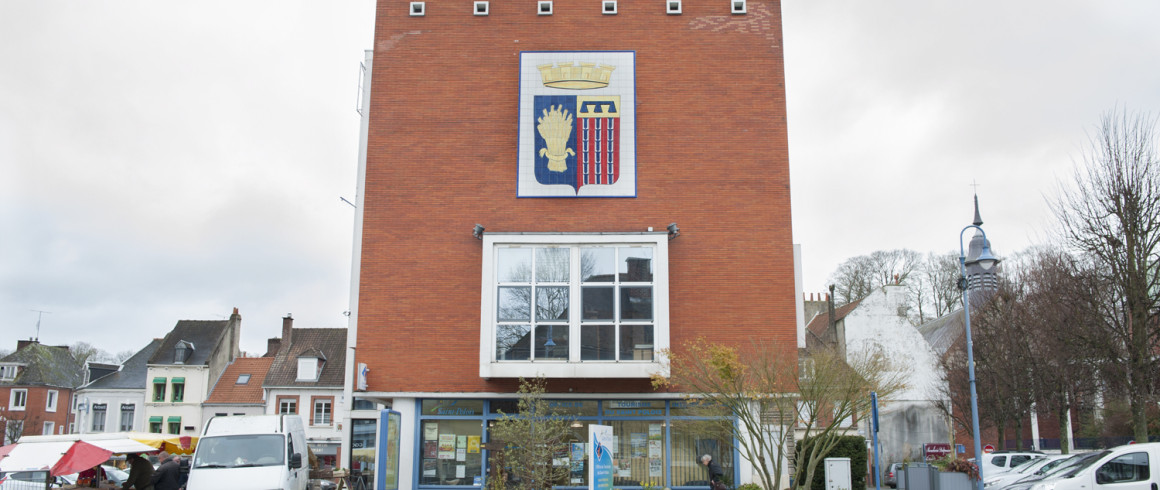The Birthplace of the Foundress
Pembroke College was founded on Christmas Eve, 1347, by Marie de St Pol, the widow of the Earl of Pembroke. Marie was born in St. Pol-sur-Ternoise, a small town near Calais in northern France. Pembroke alumnus Barrie Cross (1956) recently moved to the town and has been doing some research on the Foundress and her birthplace. Here, he reports on the history of St. Pol-sur-Ternoise.
Our thanks for the photos are due to Maxime Briand.
The first castle to stand on the hill that rises steeply behind the town of St. Pol-sur-Ternoise and which is known today as « Le Mont » was built early in the eleventh century. The home and stronghold of the Counts of St. Pol, it dominated the settlement grouped around it at the foot of the hill for just a hundred years and was then attacked and razed to the ground by Charles le Bon, Count of Flanders, who then justified his sobriquet by leaving the town unscathed.
[caption id="attachment_23057" align="alignleft" width="671"] The town of St. Pol, taken from the bridge over the railway line. In the background is the mound where the old castle stood.[/caption]
The town of St. Pol, taken from the bridge over the railway line. In the background is the mound where the old castle stood.[/caption]
The construction of a second castle was begun some five years later. Greater attention was paid this time to building defenses which would secure it against attacks from the vulnerable north and, by the end of the thirteenth century, boasting other fortifications including a central tower, a strong fortress and seigneurial residence stood on the hill. This was the castle that Marie de St. Pol, the foundress, would have known, where she was probably born and lived her early years. It, too, however, though it stood for a long while, was still not impregnable and stood little chance of resisting the hordes that Charles V of Spain unleashed on the region. It fell to his attacks in 1537.
[caption id="attachment_23059" align="alignleft" width="671"] The side of the town hall, featuring the St. Pol coat of arms. The right half is shared with Pembroke, and the left half is that of the Campdavene family, from whom Marie's family inherited the earldom.[/caption]
The side of the town hall, featuring the St. Pol coat of arms. The right half is shared with Pembroke, and the left half is that of the Campdavene family, from whom Marie's family inherited the earldom.[/caption]
No attempt was made to build a third castle and the ruins left by Charles V were used by the people of the town as a quarry for building stone so that eventually only the merest traces of Marie's home remained. Those vestiges are still visible in the grounds of the castle which, after becoming a listed site (« Monument Historique »), was bought by the town and became a municipal park.
As to the town itself (and its 5,500 inhabitants today), a settlement certainly existed in the ninth century as a pretty legend is recounted in a chronicle dating from that time which describes how it got its name. Fearing attack from marauding Norsemen, the inhabitants prayed to St. Paul for help and, in answer, he hid the settlement in the densest of fogs and thereby saved it. The grateful people then honored the saint by dedicating the settlement to him, a homage only denied him for nine years during the revolutionary period, when, officially at least, St. Pol went by the drab name of « Ternois Libre ».
But no miraculous weather conditions were available, it would seem, when in 1537, after razing the castle to the ground, Charles V dealt in similar fashion with the town. Four hundred years of safety from attacks and growing prosperity followed and then, in final years of the last war, allied bombers reduced 75% of the town to rubble. Such destruction was unavoidable since it was essential to prevent the German forces from using both the road and rail routes that centre on the town and its marshalling yards and thereby supplying their front in Normandy and, especially, the V1 and V2 sites in the immediate vicinity.
[caption id="attachment_23061" align="alignleft" width="671"] The castle mound and ruins[/caption]
The castle mound and ruins[/caption]
Rebuilt pleasantly, largely in red brick, the material that predominated in the old town and which has produced above all a handsome modern church (deserving a better belfry!), the town grew active again, serving the needs of the constellation of villages which are found in the rich agricultural region which surrounds the town. But, alas, the north-south road passage again brought dire problems as the traffic using it became steadily more frequent and heavy over the more recent decades. Only in October of 2015 was a by-pass finally opened after years of wrangling over cost and course, and, with a sigh of relief, life become pleasant and commercially possible again in the town centre.
(All photos by Maxime Briand)
